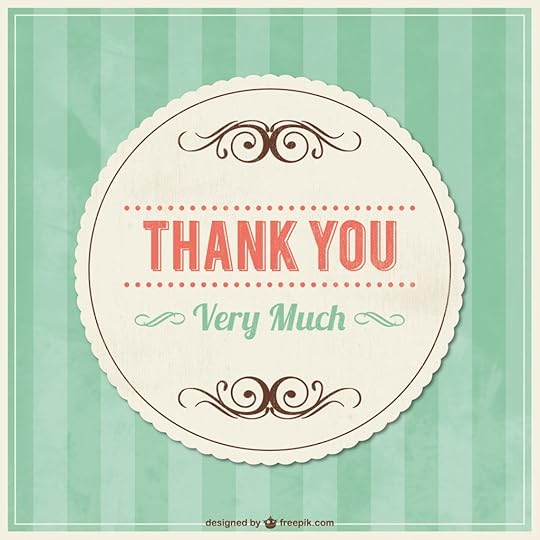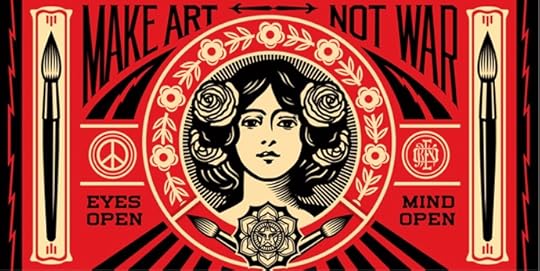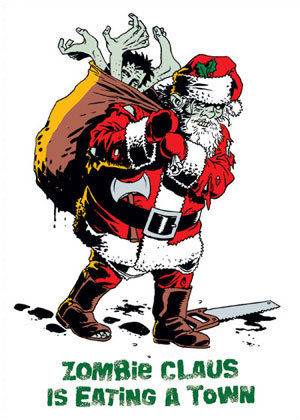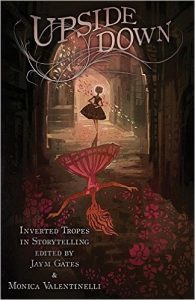Monica Valentinelli's Blog: booksofm.com, page 28
December 21, 2016
Because Santa Cards are Way Better with Zombies

I want to get rocking on my Make Art Not War 2017 Challenge, and as part of that one of my “wish list” items is to squee about something cool that I really enjoy. Today’s squee is timely, and it’s about Michael Spradlin’s Zombie Christmas Cards. I found out we had a couple of these left, and off in the mail they went with braaaaaaiiiiiiinnnnnnnnnnsssssss.
Anyway, I dig Michael’s illustrations and the jokes for these cards. Zombies are a nice, geeky way to share the holiday spirit for those who appreciate the undead with their candy canes and nog.
Here’s a picture of one of the cards; if you click on it, it’ll take you to www.zombie-cards.com where you can see both illustrations, their interiors, and buy a set for next year.
Mood: Meh. Meh.
Caffeinated Beverages Consumed: Triple meh.
Work-Out Minutes Logged Yesterday: Quadruple argh.
In My Ears: Computer fan.
Game Last Played: Dragon Age: Inquisition
Book Last Read: The Coldest Girl in Coldtown by Holly Black
Movie/TV Show Last Viewed: Game of Thrones
Latest Artistic Project: Make Art Not War 2017 Challenge and Rules
Latest Releases: Read my end-of-the-year list of releases for an overview of what I’ve put out for 2016. Check out Upside Down: Inverted Tropes in Storytelling and, if you like it, consider leaving a review.
Current State of Projects: Read my latest project update.




December 20, 2016
Make Art Not War 2017 Challenge & Rules
Born out of both my personal experiences and the knowledge that oppression tends to crush the artistic spirit on a cellular level, I have created a Make Art Not War 2017 Challenge for those who need it. This challenge, which came together from inspiration to draft guidelines, is designed to be flexible to work with your talents and lifestyle. Don’t be afraid to customize the specifics to fit your needs. Your art? Your rules.
Why take the Make Art Not War 2017 Challenge? When times are tough, the feeling that artists are not necessary tends to permeate because art is viewed as a luxury item in some cultures since we don’t produce food, clothing, or housing. The exact opposite is true, because art is a documentation and representation of our humanity and all our struggles. People turn to stories to find hope, to be inspired, to reach inside themselves and discover their own courage. This challenge is about making art to tap into your voice and tell your story. After all, one story can change the world. The problem is, we have no idea which story that will be, when it will be told, or in what medium. It’s up to us to find it–by making art!
Make Art Not War 2017 Challenge
I’ve designed the challenge to be simple, but grounded in four actionable areas. They are: Motivation, Discipline, Accountability, and Connection.
Rules Summary
This is a summary of the rules I’ve designed for the challenge. In the longer version, I offer means of customization to fit your lifestyles. After you’ve read the rules, write down in four-to-five sentences what you’ll pledge to do for 2017 and post them publicly or privately. Combined, those actionable items will help keep you grounded and focused on making art, while remaining connected to the world around you.
My Make Art Not War 2017 Challenge pledge:
I pledge to devote one hour a day to my original art.
If I don’t feel motivated, I pledge to write down the reasons why I wanted to take this challenge for fifteen minutes or one-to-three pages whichever comes first.
I pledge to mark down on the calendar whenever I complete a day’s efforts.
As the challenge creator, I pledge to create a weekly accountability post every Wednesday beginning on January 9th. Comments will be open. Hashtag #makeartnotwar2017 #manw2017
I pledge to check into social media twice a week for personal use, and once a month with my local community of artists and writers.
Motivation
Find your personal reason to make art and use that as your rallying cry for 2017.
Artists are human beings, not robots. Writers need to discover our characters’ voices. Painters need to glance at a blank canvas and draw that first line. Musicians need to hear the first stanza. Sometimes, however, we get stuck. We don’t know what to write. We don’t know if our art will resonate. We don’t see how our words will matter–because we can’t predict the future so we freeze up. We punish ourselves. Then, we read the news and get depressed; or, we get bad news and get even more depressed. Caught in that never-ending cycle of wondering what our worth is, some artists cease to create altogether.
There are 1,000 reasons to never pick up that pen, that inkwell, that stylus. What is more important? Those precious few reasons why you’re making art. Before you begin the challenge, figure out why you want to make art to find your motivation. Maybe you have a mantra, like “I want to make readers laugh.” Maybe, however, making art is so ingrained in your identity you might say: “I need to write to be happy.” Or, maybe you have a goal or business plan that helps keep you grounded on: “I need to draw to pay the bills”.
When you get stuck, take fifteen minutes and remind yourself that you’ve taken this challenge because your art is important to you. Abandoning the act of making art is not an option, and you will not retreat. Say that reason out loud, sing it, letter it, draw it–whatever you need to do. Focus on that mantra and recharge your artistic batteries, for the well of inspiration you draw from will never empty, not as long as you have the will to draw from it. After all, motivation is about reminding yourself how to find the will to make art when you lose it.
Discipline
Discipline is the time you will take every day in 2017 to make art.
The challenge is designed around spending one hour every day to make your original art.
Modifications are as follows:
Subtract Half an Hour: Thirty minutes is good for beginners! If this allotted time does not challenge you, however, consider upping it to 45 minutes or an hour.
Add Fifteen Minutes: Tackle one household chore or personal health item every day like making the bed, eating vegetables, flossing, etc.
Add Half an Hour: Get moving, get grooving. Pledge to dedicate this time to a physical activity like biking, climbing stairs, going for a walk, going to the gym, etc.
Add an Hour: Switch techniques, genres, art forms and start something brand new–or double your time.
One thing to keep in mind, is that it doesn’t matter how good the art is you make if you are learning. Stretching the boundaries of what you normally do often means that your first attempts will probably suck. That’s okay! Give yourself permission to suck, but also to improve, revise, refine. You cannot see how far you’ve come, or how you’ve internalized the techniques you’ve been practicing, unless you put the time in. This is why discipline is needed to keep you on track.
A few things to think about depending upon your situation:
One hour writing sprints typically yield 750 to 1,200 words of text.
To hit the NaNoWriMo word count goal of 50,000, you would average 1.5 to 2 hours of writing every day.
If you’re a professional artist, consider using this hour to create something you haven’t sold or been contracted to create yet. Think of this as your pie-in-the-sky wish list!
If you need supplies, pay yourself a dollar every time you make art.
If you have kids, roommates, or family obligations, consider working out a time where you have an hour to yourself or, alternatively, break it up into two half-hour segments.
To instill discipline, you will need consistency. If you know you’re going to miss a day, either plan to make it up (if that works for you) or spend half the time on it instead.
The keys to making your own art on a regular basis is commitment. The motivation is the “why”, the discipline is the “how”, and the accountability is the “what”.
Accountability
Pledge to hold yourself accountable to this Make Art Not War 2017 Challenge.
It’s one thing to say you’re going to make art or write that novel or what have you, it’s another to actually do it. Accountability is about proving to yourself that you have done the work you pledged to do.
Methods for accountability include:
Use a diary and write journal entries to mark your progress.
Buy a calendar and put smiley face stickers on it, or use the calendar on your phone.
Buddy up and find someone else who’s taking this challenge to hold each other accountable.
Check in every Wednesday here on my website, beginning on January 4th. Comments will be open.
Print out a free calendar and “X” off the days.
Use the hashtag #makeartnotwar2017 or #manw2017. Share your efforts every week–even talking about it with other challengers will help!
Accountability doesn’t have to take a long time; just by checking off a date on your calendar right after you’re done will complete this part of the challenge. There is no greater sense of accomplishment than being able to quickly look back at what you’ve done. Super important!
Connection
Manage your connections with your online and offline communities to remain focused but grounded.
For this challenge, connection taps back into the reasons why you’re making art. A story you write could make someone cry. A digital painting you create could instill a sense of wonder. The art you produce is a unique part of your identity, your humanity, and at the other end of your art is a reader, viewer, or player who’s interacting with your creation. Often, the best art evokes an emotional reaction, regardless of how well its crafted. Our relationships help give us the connections needed to understand the spectrum of human emotion. They also provide the means for self-care, and a tool to help us support one another.
Unfortunately, our connections can work against us because there are so many different ways to connect, that they wind up distracting us from what we want to accomplish as artists. The truth is that artists need solitude in order to create; being alone, even when it’s depicted in a positive, almost spiritual light, carries many stigmas with it. We hear the word “loner” and internalize our need or enjoyment of solitude as being wrong or bad or a sign that we’re broken. We need that “alone time” to focus, to listen to our innermost selves, to channel our voices into making art before we can share our creations with others.
This leg of the challenge is about managing your ability to connect against the discipline required to make art. For me, that is broken up into two, distinct parts: offline and online. Your mileage on these two areas in particular will vary widely, depending upon your situation.
I am listing below what I’m pledging to do for my challenge, in the hopes that you’ll use this as a baseline.
Weekly Check-In: Pending any work-related promotions, interviews, this challenge, etc., I pledge to check in to social media no more than twice a week for personal usage.
Quarterly Downtime: A few years ago, I took 100 days off of social media , and since then I’ve found that it took me two weeks to reset. I usually take the week off after a big show, but I will consider taking more of these breaks if limiting my access is not effective.
Monthly Connection: I started this back in October/November, but it bears repeating now. Once a month, I am connecting with other artists/writers in my local community–outside of convention season.
Now that I’ve written the rules, it’s time to spend the last two weeks of the year reflecting on what I want to do for my challenge by reviewing what I’ve got on deck. I will post next week about this in particular, to help you prepare as well.
Rise up. And take the Make Art Not War 2017 Challenge with me!





December 16, 2016
Thank You For a Successful Anthology Launch

Thank You eCard! Really appreciate the signal boost for Upside Down: Inverted Tropes in Storytelling. Woo!
Thanks so much for backing the Kickstarter, spreading the word, and being patient with me for the release of Upside Down: Inverted Tropes in Storytelling. We were all thrilled with the starred review from Publisher’s Weekly prior to its release, and have been working on guest blogs hosted by literary luminaries such as John Scalzi and Mary Robinette, and interviews as well. As a result of this visibility and excitement, we broke the Top 20 in three Kindle categories and debuted at #1 in Science Fiction Short Stories. We are also the number one hottest seller on DriveThruFiction.com, our digital fulfillment partner, too!
This success would not be possible without you. Thank you! Oh, and before I wander off to scare the cats, if you enjoy the collection please consider leaving a review. That helps your fellow readers know what the stories are all about, and it also adds a vote–which is crucial for online bookstores.




December 15, 2016
Make Art Not War 2017 (Part 2): Draft Guidelines

Make Art Not War is a phrase that’s been popularized by street artist Shepard Fairy in a series of murals, like the one pictured above, found in Los Angeles and other parts of California. The phrase is simple. Powerful. The imagery clear. And it is my motto for 2017 for these reasons.
To that end, I’m devoting 2017 to a simple art challenge using a series of mantras and basic guidelines. The one I concocted is Don’t Get Mad, Make Art, and you can read about how I applied that over on Scalzi’s “Whatever” Blog in The Big Idea with Monica Valentinelli. All my frustration, all my rage, all my sorrow and empathy and joy… I want to finish sharpening my sword and engraving it to make a mega-butt ton of my own art in 2017.
Why am I keeping the rules for this simple? Couple of reasons. First, after working full-time as a writer, what I’ve found is that while discipline is crucial to making art, working on my own stuff fell to the wayside. And, I’m going to tell you why that is: money. If I can’t justify spending the time on something, I don’t do it because I can’t see the benefit. Even with Upside Down, which had a great launch, there was a lot of risk involved from the start. What if the collection isn’t received well? What if the slush pile doesn’t yield trope-smashing stories? What if, after pulling so many people together, it doesn’t fund at all? Money isn’t something writers talk about, because there’s still this pervasive idea that either we shouldn’t make it, that we’re asking too much, or that we should suffer for our art.
I don’t want to suffer. (Been there, did that.) I’ve already made decisions and gauge, constantly, how I can make a living doing what I love the most. If I had my choice, I would devote my time to my original work and not work for anybody else–but I can’t. I can’t afford it, and I can’t turn my back on the readers who supported me from the beginning. They came from my media/tie-in efforts, and I’m very grateful and aware of how I’ve grown as a result. Maybe some day I’ll have the power to command publishers and hordes of readers at my beck and call, but being as pragmatic as I am… Well, there aren’t a lot of writers who do and who can. Instead, we have to make it work with the tools and resources we have at our disposal, and I’m using this as a chance to bring my original worlds and stories into the world.
Another reason why I want to create simple guidelines, is because there are a lot of new writers and hobbyists out there who (have told me) are intimidated by any kind of challenge. It’s frustrating for them, because they haven’t internalized how to make the thing they love so they either never start, don’t find the time, or get discouraged. Unfortunately, the only way to learn is by doing. All the great ideas in the world can never manifest unless you shimmy and get out there and make art!
Without further adieu, here are the draft guidelines for my challenge. Comments welcome!
Author’s Note: I will post the manifesto and guidelines next week, so we have time to prepare for January 1, 2017.
Draft Guidelines for Make Art Not War 2017 Challenge
What I want to do for the 2017 challenge guidelines, is to cover three areas: time, tracking, and check-in. I don’t want to shape the challenge by telling people “what” to make, though I might toss a few fun bits in throughout the year to inspire y’all. I’m using some of the disciplinary practices I had to do when I used to play piano as a baseline.
1. Daily Practice: Devote one hour a day to making original art. Yes, all 365 days a year! If, barring sickness and what have you, a day is missed it needs to be made up.
2. Weekly Practice: I will post a minimum of two blogs per week. The first will be a check-in to see how both myself and everybody else’s doing. Comments will be open, so you can post links to your websites if you have something new to share. The second, will be about some cool thing I like. In other words, while this challenge is about making my own art, I can still support you (the reader) and my peers. I don’t want to say “I will post metrics, I will post what I’ve done, I will post pictures…” That feels a little too show-y to me, and I think that needs to be more organic than that.
3. And lastly… Social Media Usage: Okay, so originally I thought about taking a year off from social media, but that won’t work. I’ve got a lot of releases coming out, I’ve got fans to chat with, and unfortunately the vast majority of my writerly friends are more introverted than I am. Instead, I want to limit my public engagement for the entire year to no more than twice a week. I’ve got a few private means to keep in contact with friends and whatnot; this is the Twitter/Facebook/whatever stuff.
Thoughts? Am I in the right direction or do I need rethink this?




December 14, 2016
Make Art Not War With Me In 2017 (Part One)

Back when Bush, Jr. was in office, I remember thinking to myself that his presidency would solidify the shape of the future. Either we were going to figure out how to stop the divisiveness that was forming between the two major parties, or eventually that divide would become a chasm they couldn’t cross without a common enemy. I don’t know whether or not I’m right. When it comes to politics, I think about patterns as opposed to saying one President or another is totally to blame. My concern has always been about bi-partisanship, because people aren’t as reductive as we think they are. We’re complicated. Can our politicians set aside their differences and come to the table to attend to the needs of governance? And, perhaps more importantly, why have we given in to extremist or fringe ideologies? What is the solution when people are reduced to sides, and you’re either for or against one another?
I think about what happened when Walker took office and began attacking the Wisconsin unions; people were so angry that they started to sing the Star Spangled Banner. Afterwards, I witnessed how yellow journalism had to paint a clearly one-sided war against Unions as having “two, equally-numbered sides.” The subtext for attacking the unions was politically-motivated, because unions tend to donate to Democratic campaigns, and that was a blip in the larger conversation. Anyway, 100,000 protesters against the governor’s policies, and a handful of opposing protesters bused in–both filmed as having equal weight and numbers. Even then, it took six-to-eight weeks for anyone to pick up on what was happening, and by then it was too late. The idea that this was an organized, violent protest began circulating. The truth, was that so many people organically came to protest, that they needed to be organized. Unions were “dirty thugs” and “fat cats”. Teachers, firemen, machinists, state workers and, much later, police officers became the bad guys. And, because they became “the” bad guys, you couldn’t walk anywhere without being impacted by the us vs. them mentality. You were either for or against your neighbors, co-workers, friends, family, and everyone else you interacted with.
Emotionally, it was very trying for a lot of people. There was no escaping it. On the ground we were also experiencing one thing, and the media and politicians who were afraid of people speaking up were depicting another. I don’t blame the media for what happened, though. Part of this, was what I feel is a technical issue which is the same problem that has facilitated fake news. When telling a story, which is what all articles are, appealing to people’s emotions is the best way to get eyeballs on the page. Instead of the news being delivered to a rapt audience via a newspaper in the morning or at night, or via the nightly news at a specific time, we have 24-7 news which is not sustainable. So, news that affects people on a local level gets stretched out ad infinitum, because the outlets have to stay in business somehow. Now, however, now that journalists are needed again and advertorials, fake news, and what “sounds” good is valued over facts… Well, you can see how people can get easily confused or frustrated, especially when they’re living and feeling the effects of what’s happening on the ground. Even then, the emotions generated by the news aren’t within the full spectrum, because outrage is more shareable than hearing how people are hurting–just look at what’s happening in North Dakota and Flint, Michigan. But, outrage doesn’t offer solutions and eventually people get tired of hearing about a situation, which allows more harm to happen.
Fast Forward to the Present
I cannot imagine what a Trump presidency will be like, and I’m not politically-savvy enough to know what the long-term effects will be either. I suspect there will be a lot of fighting, misinformation, and us vs. them on a national scale and, if my dreams are any indication that a battle is coming? A McCarthy-esque battle is coming for the soul of this country that will be felt in every city, town, and suburb and may have global repercussions. People are already getting hurt, according to the Southern Poverty Law Center, but much worse–there are a fair number of folks who don’t believe that crimes of hate are on the rise.
Worse, the traits that used to be associated with being a good Christian–empathy, compassion, helping the poor–seem to be regulated now to “bleeding heart lefties”. That leaves me speechless, that the very best of what it means to be human is regulated to a political ideology. If you’re a good person, you’re frowned upon for being weak. Being decent is no longer a goal to shoot for, it’s something to stomp on, and I don’t know why.
So what can I do? I have a teeny tiny amount of fame, friends I don’t see often enough, a small but growing readership, and a lot of peers that are struggling right alongside with me. I’m your average jane schmo artist with a big mouth, a big heart, and a lust for making art and reveling in the joy and resulting conversations. That’s what I know how to do, but I also know something else. I know what my life experiences have taught me, and I know what kind of a person I could have been if I wasn’t open to learning. I know a lot about the industry (enough to make me dangerous), and help where I can, when I can.
Unfortunately, I can’t fix what’s coming. I’m not a politician. I’m not loaded. I’m not powerful. And, I don’t want to be “known” for my politics, anyway. What I can do, is make art. I believe that a story can change the world. The problem is, no one knows which one that will be–which is why more stories will always need to be told.
What does this mean for 2017? I’m creating a Make Art Not War Challenge for myself, to push the boundaries of what I normally do. I’ll post the specific details in a follow-up post, but more than that… I want you to consider taking this challenge (or something like it) with me. Hobbyist, part-time artist, full-time artist, whatever! Art is needed now, more than ever, because this is how we can remind each other of all the complexities and depths of emotions that we share as human beings.
Mood: Hump Day Redux
Caffeinated Beverages Consumed: There’s no bottom to this coffee pot.
Work-Out Minutes Logged Yesterday: Blargh, blech, blargh.
In My Ears: The wind. (Seriously, it’s strong as hell out there.)
Game Last Played: Dragon Age: Inquisition
Book Last Read: The Coldest Girl in Coldtown by Holly Black
Movie/TV Show Last Viewed: Game of Thrones
Latest Artistic Project: My sekrit project.
Latest Releases: Read my end-of-the-year list of releases for an overview of what I’ve put out for 2016.
Current State of Projects: Read my latest project update.




[Announcement] Writing the Other 2017 Classes
I am pleased to share that I am teaching a Writing the Other class about RPGs in February 2017. The full text of the announcement, including instructions on how to get updates, is on the newly revamped www.writingtheother.com website.
In addition to the classes that I am teaching, I thought you might be interested in the works of these talented instructors. Please consider checking them out!
New Writing the Other Classes
2017 is almost here and we’re already planning a full year of Writing the Other classes! In addition to Weekend Intensives every other month there will be at least three Multi-week Classes. And we have an exciting roster of new classes and Master Classes coming up:
Writing Inclusive Games – Creating RPGs Sans Fail with Monica Valentinelli | February 2017
Master Class: Writing Bisexual Characters with Faith Cheltenham | February 2017
Master Class: Writing Your Future Self – Creating Older Characters with Ellen Klages | early March 2017
Master Class: How To Fail Gracefully with Mary Robinette Kowal and K. Tempest Bradford | April 2017
Master Class: Avoiding Offensive Tropes in Horror with Chesya Burke | Summer 2017
Worldbuilding Intensive (instructors TBA) | Summer 2017
Master Class: Writing From the Diaspora with Ken Liu | Autumn 2017
Master Class: Beyond Belief – Writing Plausible Atheist and Religious Characters with Nisi Shawl and Cynthia Ward | Autumn 2017
We also plan to have Master Classes on Writing Lesbian and Gay Characters, Writing Characters With Mobility Disabilities, and Depicting Class in Fiction later in the year.
For more about these classes, visit www.writingtheother.com.




December 13, 2016
[New Release] Upside Down: Inverted Tropes in Storytelling
“This compendium of literary undercutting and rebuilding is both enjoyable to read and an incisive work of commentary on the genre.”
— Publishers Weekly (Starred Review)
Now Available!
Upside Down: Inverted Tropes in Storytelling is an anthology of short stories, poetry, and essays edited by Monica Valentinelli and Jaym Gates. Over two dozen authors, ranging from NYT-bestsellers and award winners to debut writers, chose a tired trope or cliche to challenge and surprise readers through their work.
Read stories inspired by tropes such as the Chainmaille Bikini, Love at First Sight, Damsels in Distress, Yellow Peril, The Black Man Dies First, The Villain Had a Crappy Childhood, The Singularity Will Cause the Apocalypse, and many more…then discover what these tropes mean to each author to find out what inspired them.
Join Maurice Broaddus, Adam Troy-Castro, Delilah S. Dawson, Shanna Germain, Sara M. Harvey, John Hornor Jacobs, Rahul Kanakia, Alethea Kontis, Valya Dudycz Lupescu, Haralmbi Markov, Sunil Patel, Kat Richardson, Nisi Shawl, Ferrett Steinmetz, Anton Strout, Michael Underwood, Alyssa Wong and many other authors as they take well-worn tropes and cliches and flip them upside down.
CONTENTS
Introduction — Jerry Gordon
SECTION I: INVERTING THE TROPES
On Loving Bad Boys: A Villanelle — Valya Dudycz Lupescu
Single, Singularity — John Hornor Jacobs
Lazzrus — Nisi Shawl
Seeking Truth — Elsa Sjunneson-Henry
Thwock — Michelle Muenzler
Can You Tell Me How to Get to Paprika Place? — Michael R. Underwood
Chosen — Anton Strout
The White Dragon — Alyssa Wong
Her Curse, How Gently It Comes Undone — Haralambi Markov
Burning Bright — Shanna Germain
Santa CIS (Episode 1: No Saint) — Alethea Kontis
Requiem for a Manic Pixie Dream — Katy Harrad & Greg Stolze
The Refrigerator in the Girlfriend — Adam-Troy Castro
The First Blood of Poppy Dupree — Delilah S. Dawson
Red Light — Sara M. Harvey
Until There Is Only Hunger — Michael Matheson
Super Duper Fly — Maurice Broaddus
Drafty as a Chain Mail Bikini — Kat Richardson
Swan Song — Michelle Lyons-McFarland
Those Who Leave — Michael Choi
Nouns of Nouns: A Mini Epic — Alex Shvartsman
Excess Light — Rahul Kanakia
The Origin of Terror — Sunil Patel
The Tangled Web — Ferrett Steinmetz
Hamsa, Hamsa, Hamsa, Tfu, Tfu, Tfu. — Alisa Schreibman
Real Women Are Dangerous — Rati Mehrotra
SECTION II: DISCUSSING THE TROPES
I’m Pretty Sure I’ve Read This Before … — Patrick Hester
Fractured Souls — Lucy A. Snyder
Into the Labyrinth: The Heroine’s Journey — A.C. Wise
Escaping the Hall of Mirrors — Victor Raymond
Tropes as Erasers: A Transgender Perspective — Keffy R.M. Kehrli
SECTION III: DEFINING THE TROPES
Afterword — Monica Valentinelli & Jaym Gates
Trope Definitions/Index of Tropes
SECTION IV: ACKNOWLEDGMENTS AND ADDITIONAL BIOS
Book Details:
Cover artist Galen Dara
TPB ISBN: 978-1-937009-44-1
HC ISBN: 978-1-937009-46-5
366 Pages
Monica Valentinelli is an editor, writer, and game developer who lurks in the dark. Her work includes stories, games, and comics for her original settings as well as media/tie-in properties such as the Firefly TV show, Brandon Sanderson’s Mistborn, and Vampire: The Masquerade. Her nonfiction includes reference materials such as Firefly: The Gorramn Shiniest Language Guide and Dictionary in the ‘Verse, and essays in books like For Exposure: The Life and Times of a Small Press Publisher. For more about Monica, visit www.booksofm.com.
Jaym Gates is an editor, author, and communications manager. She’s the editor of the Rigor Amortis, War Stories, Exalted, and Genius Loci anthologies, as well as a published author in fiction, academic nonfiction, and RPGs.




December 9, 2016
RPG Creator Relief Fund Achieves 501(3) Status and a Look Ahead
 If you recall, you might remember that I’m part of the RPG Creator Relief Fund. I’ve got great news! This year, we achieved 501(3) status and this will help the charity grow in the future to help other creators in dire need. Plus, if you’re looking for charities to donate to, your contributions are tax deductible.
If you recall, you might remember that I’m part of the RPG Creator Relief Fund. I’ve got great news! This year, we achieved 501(3) status and this will help the charity grow in the future to help other creators in dire need. Plus, if you’re looking for charities to donate to, your contributions are tax deductible.
Today, I’d like to share a statement from Sean Patrick Fannon, our Communications Director.
RPG Creator Relief Fund Entering 2017
Greetings to all of you who love RPGs and the folks who make them! There’s no arguing that 2016, while a fantastic year in terms of RPG releases and the immense creativity behind them, was a bit rough on a lot of folks who make this their vocation. Injuries, illnesses, and serious financial setbacks hit a lot of great folks, and still others are facing major challenges in the days, weeks, and months to come.
This is exactly why we created the Roleplaying Game Creators Relief Fund. Inspired by such great efforts as the Hero Initiative, we wanted to put together a way to help RPG writers, artists, editors, and other creative folks who work professionally in this field to gain help through tough times. As a 501(c)(3) nonprofit charitable organization, we need as much help as RPG fans can give us in order to fill the Fund with assets that can be called on when needed.
We experienced a lot of success this year, but we plan to do much more in 2017 and beyond. We’ll be creating more great bundles for you to purchase, with the proceeds going to the Fund. As well, we’ve got some special, exclusive projects in the works, designed specifically for the RCRF to generate much-needed money to give those in need.
We’re also exploring charity drive initiatives, such as auctions at conventions; live-cast gaming feeds; gaming group challenges; and other creative and energetic concepts to motivate the RPG community to help those who make the games and worlds we all love.
We’d love to know what gamers would like to see, as well, so please reach out to us and let us know. You can find us online at our website, or on Facebook. If you want to look at the bundles we have available at any given time, check out our DriveThruRPG page.
To all who’ve supported us so far, we thank you most profoundly, and we hope you’ll help us spread the word and get more gamers involved. We all know important it is to team up to fight the darkness and help our fellow adventurers heal and survive when times are bad.
For the RCRF Board of Directors, Board of Applicants, and Advisory Board,
Sean Patrick Fannon
Communications Director, RCRF




December 7, 2016
Geek & Sundry, I Salute You

One of the issues I, and many others have been having lately, is that it’s hard to speak up about systemic issues due to the harassment and vitriolic reactions we get for doing so. Time and time again, it doesn’t matter who is saying that there are systemic issues we’re dealing with, that person often gets attacked for pointing them out–especially with respect to something as simple as representation or equal pay. Why? Well, it’s for the simple reason that the people who work in creative industries aren’t isolated from the rest of society. If misogyny, racism, and homophobia exist in society (along with the other -ists and -isms out there), then they are also part of working in any vertical, in any industry.
Why did I choose to speak up now? Part of it was timing. Part of it was the fact that I felt my silence was actively hurting my peers and predecessors in these creative industries, because I was fulfilling the stereotypical ideal of “just do the work and stay quiet” as I have for the past ten years. But, there’s a difference between staying quiet and acknowledging that there are systemic issues. They exist. Some people disagree, because they aren’t directly impacted by those issues or they don’t align with their political views. But, for those of us who do see a problem, we all have decisions to make about what to do next. What comes after we acknowledge an issue, the solutions we seek to implement, that’s the hard part. The least I can do is say: “You are not alone in feeling this way.”
To share my feelings, I wrote an essay in Uncanny Magazine for their November issue. Much of the reasons why misogyny, etc. continue to be a problem, is because there’s a perception within the geek community that your standard geek has a monolithic white male identity both as fans and as creators. That perception is fueled by a lack of visibility and PR for the work that folks are already doing, which then leads to more disbelief when people speak up. I used (one of) many examples that happened to me, because I felt that was the only way to highlight my point that I was hoping to be credited for the work that I actually did. The people who read the essay and experienced the same issues, then, understood what I was trying to say. In it, I pointed out that Geek & Sundry did not list my name on their Court of Shadows review, even though Jason Hardy and I co-developed this Shadowrun supplement and I was the lead writer penning 40,000+ words.
In response, Geek & Sundry acted with grace and aplomb by doing the following:
1) A different writer, Ben Riggs, followed up with me to get a statement for a new article they planned to write.
2) They did not roast the other writer over the coals, or get defensive(1). Geek & Sundry took responsibility for the oversight as an error on their part as a major media outlet–this is super important!
3) G&S apologized, and then featured my work in a new article–plus plugged my new anthology Upside Down: Inverted Tropes in Storytelling which they did not have to do.
This is exactly how situations like this should be handled, and I really appreciate Geek & Sundry taking the time to not only listen and make it right(2) but go above and beyond by writing a feature article about it.
So thank you, Geek & Sundry, for reviving this discussion; I’m seeing a positive impact in my corner of the geekosphere to the extent that new discussions are happening as well. To those of you who are sensing there are systemic issues: yes, there are and yes, they do exist. Focusing on the work can help (and it is what I tend to do), but please do not be afraid to reach out to your peers and get the support you need. You are human, you have feelings, and self-care is extremely important. Your art, your voice–it matters. Now, go make some art!
(1) Alternatively, I’ve seen and experienced the exact opposite where the company a) denies there was a problem, b) tries to explain away or misplace blame, c) throws a freelancer under the bus, and d) goes on the offensive. That is how not to handle situations like this, because you’re operating your company from the assumption that the person speaking up is not credible.
(2) Most of the responses to this article have been positive, but if you want to get a taste of what many women experience for speaking up you can visit the Geek & Sundry Facebook page. It’s not the first time I’ve heard negative comments like these. They’re often said every damn time a woman tries to speak up. Every. Damn. Time.
Mood: Hump Day
Caffeinated Beverages Consumed: Going for Round Two.
Work-Out Minutes Logged Yesterday: Double argh.
In My Ears: Sister Rust by Damon Albarn
Game Last Played: Neko Atsume
Book Last Read: The Coldest Girl in Coldtown by Holly Black
Movie/TV Show Last Viewed: Game of Thrones
Latest Artistic Project: My sekrit project.
Latest Releases: Read my end-of-the-year list of releases for an overview of what I’ve put out for 2016.
Current State of Projects: Read my latest project update.




December 6, 2016
My 2016 Year-End Publications Post
I’m pleased to share with you my 2016 releases in gaming, fiction, and non-fiction. This year, my specific goal was to shore up my non-fiction to (hopefully) get more opportunities in that area. I also wanted to write some media/tie-in stories, to dip my toes back in before submitting my original work. Plus, I’ve been very happy to edit anthologies as well and enjoy doing that work.
There’s a possibility there will be one or two more releases by the end of this year as well, but that will be in games as opposed to fiction or non-fiction.
A note about awards eligibility: I’d really appreciate it if you considered my work when you’re thinking about awards next year. It does mean a lot that you’re taking the time to think deeply about my art, and I do appreciate it. Thank you!
Fiction
I published three short stories this year, and all of them were for established settings.
“Redder Than Red”, ENDLESS AGES for Vampire: The Masquerade, 2016, Onyx Path Publishing
“Suffering of the Unchosen”, TALES OF THE DARK ERAS, 2016, Onyx Path Publishing
“My Enemy, Mi Amici”, DRAWING DESTINY: A Sixth World Tarot Anthology, 2016, Catalyst Game Labs
I also edited two anthologies as well. The first is a media/tie-in collection, and the second is an anthology I conceptualized that examines tropes through a literary lens.
THE CAINITE CONSPIRACIES, Vampire: The Masquerade Dark Ages 20th Anniversary Edition, 2016, Onyx Path Publishing
UPSIDE DOWN: Inverted Tropes in Storytelling, 2016, Apex Publications
Non-Fiction
The big release this year, was a reference book I wrote and helped design for the Firefly TV show. Jenny Lynn, the show’s translator, also lent her talents to answer questions in an interview, and to offer a definitive and thorough look at the Mandarin Chinese used in the show. Additionally, I also started a column for the SFWA about writing for games as well, and that column kicked off in November.
THE GORRAMN SHINIEST LANGUAGE GUIDE AND PHRASEBOOK IN THE ‘VERSE, 2016, Titan Publishing
“We Have Always Been Here, Motherfucker”, Uncanny Magazine, November 2016
Games
I’ve been very happy and so pleased to add the legendary Dungeons & Dragons to my list of published games this year. So awesome!
IN VOLO’S WAKE, Dungeons & Dragons 5th Edition, 2016, Wizards of the Coast
COURT OF SHADOWS, 2016, Catalyst Game Labs
GHOULS & REVENANTS, Vampire: the Masquerade, 2016, Onyx Path/White Wolf Publishing
DARK ERAS, Hunter: the Vigil “Doubting Souls”, 2016, Onyx Path/White Wolf Publishing
CODEX INFERNUS, 2016, Gun Metal Games
BATTLE FOR THE UNDERCITY for Dungeons & Dragons 5th Edition, 2016, DMsguild.com (Self)




booksofm.com
- Monica Valentinelli's profile
- 34 followers





